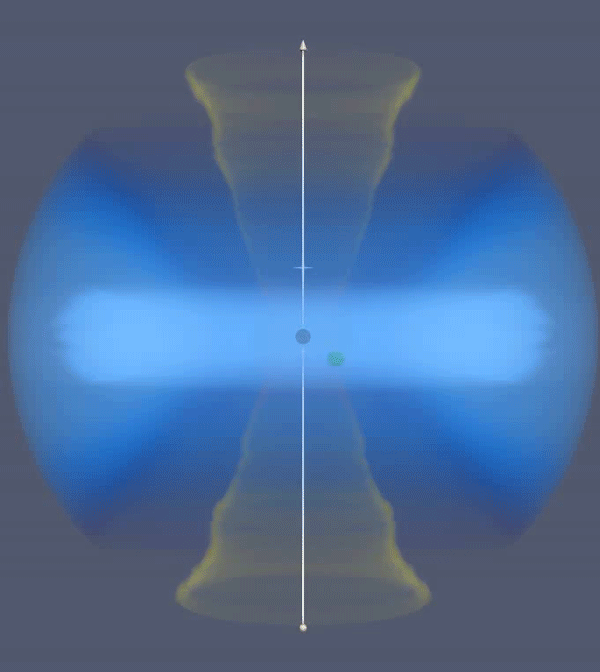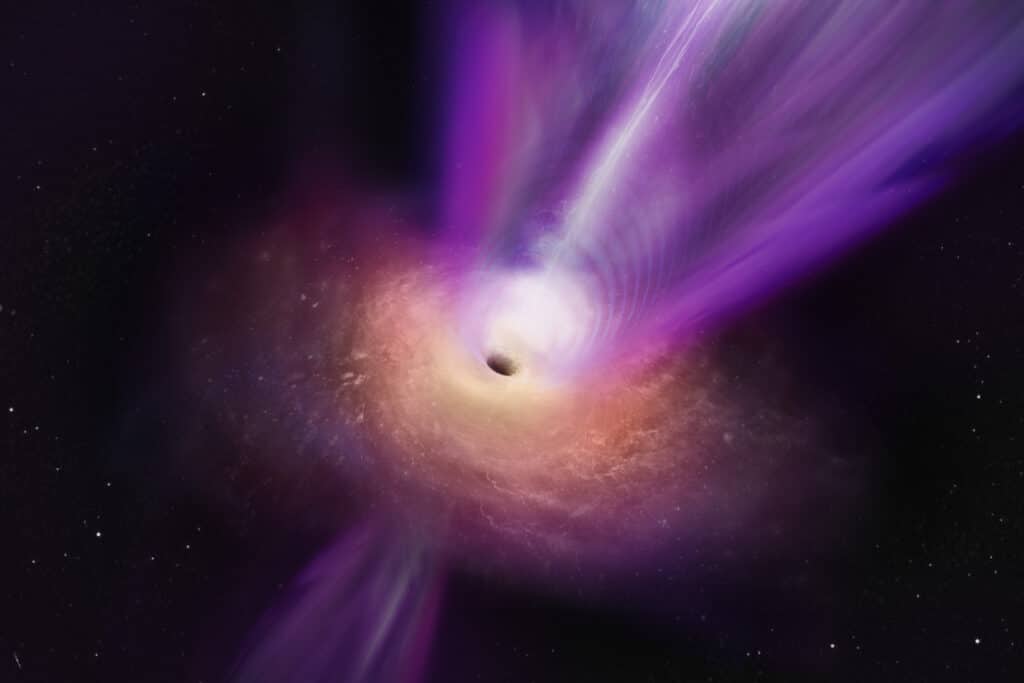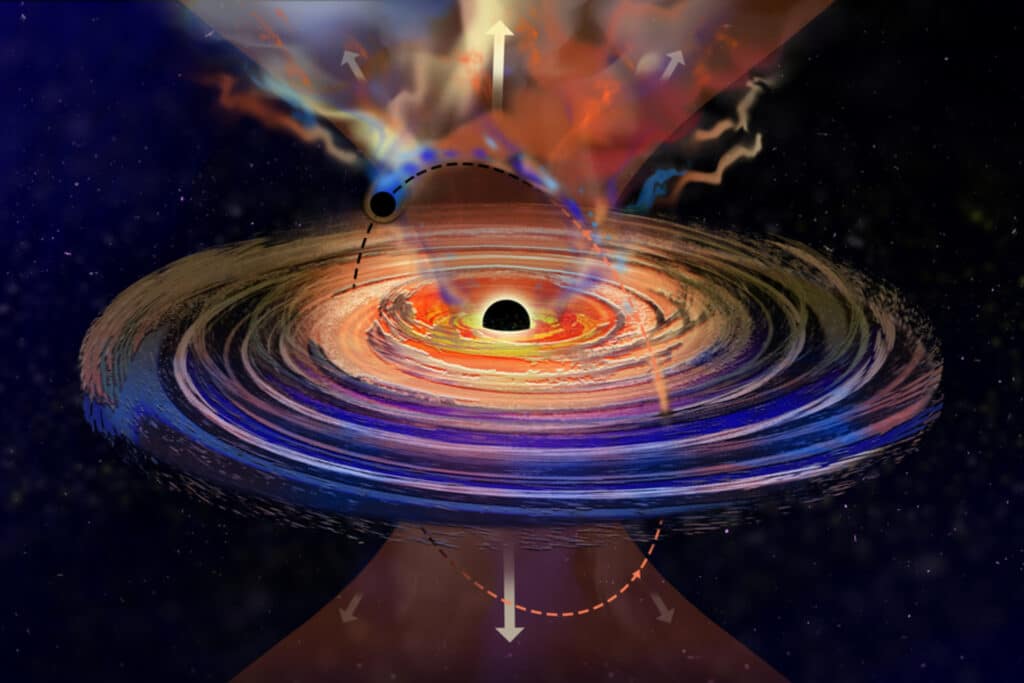Imagine a cosmic dance unlike any other, where two black holes — the universe’s most enigmatic entities — twirl around each other in a captivating display of gravity. While such a dance was thought to be impossible to observe, a team of astronomers has recently stumbled upon what might be the first glimpse of this mesmerizing phenomenon.
The discovery, written about and published in the journal Science Advances, centers around an unusual event known as ASASSN-20qc. This peculiar behavior was first spotted by the All Sky Automated Survey for SuperNovae (ASAS-SN), a network of 20 robotic telescopes that keep a watchful eye on the sky. In December 2020, these telescopes noticed a burst of light coming from a galaxy about 800 million light-years away. To put that into perspective, when the light from this galaxy first started its journey towards Earth, dinosaurs were still roaming our planet!

Initially, ASASSN-20qc appeared to be just another flaring event in a distant galaxy. However, when astronomers turned their x-ray eyes to it roughly 52 days later using NASA’s Neil Gehrels Swift Observatory, they were in for a surprise. The x-ray data revealed a curious pattern — outbursts that repeated about every 8.5 days, like clockwork.
This regularity was unlike anything seen before in such events. The team, led by Dr. Dheeraj Pasham from the Massachusetts Institute of Technology, dubbed these pulsations “quasi-periodic outflows” or QPOuts.
“We thought we knew a lot about black holes, but this is telling us there are a lot more things they can do,” says Dr. Pasham, the lead study author and a research scientist in MIT’s Kavli Institute for Astrophysics and Space Research, in a media release. “We think there will be many more systems like this, and we just need to take more data to find them.”
So, what could be causing these strange hiccups? The answer, astronomers believe, lies in a cosmic game of David and Goliath.
Researchers considered several possibilities, including disk instabilities, accretion disk precession, and even the tantalizing idea of a partial tidal disruption event (TDE), where a star is partially shredded by a black hole’s intense gravity.
However, none of these explanations could satisfactorily account for the observed QPOuts. Instead, the team proposed a fascinating scenario involving not one, but two black holes.
Picture this: a supermassive black hole, weighing as much as 50 million suns, sitting at the center of the galaxy. Orbiting around it is a smaller, “intermediate-mass” black hole, a mere 100 to 10,000 times the mass of our sun. As this smaller black hole zips around its giant companion, it periodically punches through the supermassive black hole’s disk of gas and dust, like a child cannon-balling into a pool.
Each time the smaller black hole takes the plunge, it launches a plume of gas out of the disk, which gets flung even further by powerful magnetic fields. If one of these plumes happens to be aimed directly at our telescopes, we see it as a brief dip in the galaxy’s brightness.
This cosmic game of “whack-a-mole” challenges the conventional picture of black hole accretion disks, which astronomers had always thought were relatively uniform, pancake-like structures. Instead, it suggests that these disks might be more diverse, housing not just gas and dust, but also other black holes and even entire stars!
To test this idea, researchers turned to sophisticated computer simulations. Using a technique known as general relativistic magnetohydrodynamics (GRMHD), they modeled the complex interplay of gravity, magnetic fields, and hot gas in the extreme environment around black holes.
The simulations showed that a binary black hole system could indeed produce QPOuts similar to those seen in ASASSN-20qc. The key was the smaller black hole’s orbit — slightly elliptical and inclined relative to the accretion disk.
This configuration allows the smaller black hole to periodically “dip” into the disk, stirring up matter and triggering outflows. The simulations even reproduced the roughly 8.5-day periodicity, providing compelling evidence for the binary black hole interpretation.
“I was scratching my head as to what this means because this pattern doesn’t fit anything that we know about these systems,” recalls Dr. Pasham.
If confirmed, this discovery would mark the first detection of a close binary supermassive black hole system through electromagnetic observations. Such a find would open up a new window into the fascinating world of binary black holes, which until now have primarily been studied through the ripples they create in spacetime, known as gravitational waves.

Beyond the excitement of the discovery itself, QPOuts could serve as a new tool for identifying and studying these elusive binary systems. By searching for the telltale X-ray pulsations, astronomers may be able to uncover more of these cosmic dancers hiding in the hearts of galaxies.
“This is a different beast,” notes Dr. Pasham. “It doesn’t fit anything that we know about these systems. We’re seeing evidence of objects going in and through the disk, at different angles, which challenges the traditional picture of a simple gaseous disk around black holes. We think there is a huge population of these systems out there.”
As the astronomers continue to monitor ASASSN-20qc and search for similar events, we may be on the cusp of a new era in black hole astronomy. The cosmic dance of binary black holes, once thought impossible to witness, may soon take center stage, revealing the universe’s most intimate gravitational duets.













So just to be clear, a ‘black hole’ is a space where gravity is so dense that nothing, not even photons, can escape, but another black hole can regularly pop in and out every 8.5 days and escape causing a splash without being captured.
Oh yes, it makes sense to me.